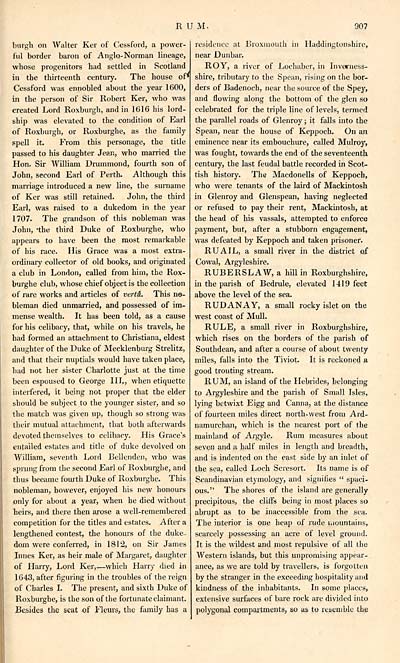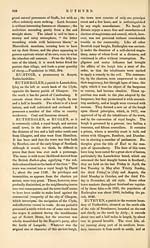Gazetteer of Scotland > Volume 2
(427) Page 907
Download files
Complete book:
Individual page:
Thumbnail gallery: Grid view | List view

R U M.
907
burgh on Walter Ker of Cessford, a power-
ful border baron of Anglo-Norman lineage,
whose progenitors had settled in Scotland
in the thirteenth century. The house of'
Cessford was ennobled about the year 1600,
in the person of Sir Robert Ker, who was
created Lord Roxburgh, and in 1616 his lord-
ship was elevated to the condition of Earl
of Roxburgh, or Roxburghe, as the family
spell it. From this personage, the title
passed to his daughter Jean, who married the
Hon. Sir William Drummond, fourth son of
John, second Earl of Perth. Although this
marriage introduced a new line, the surname
of Ker was still retained. John, the third
Earl, was raised to a dukedom in the year
1707. The grandson of this nobleman was
John, -the third Duke of Roxburghe, who
appears to have been the most remarkable
of his race. His Grace was a most extra-
ordinary collector of old books, and originated
a club in London, called from him, the Rox-
burghe club, whose chief object is the collection
of rare works and articles of vertA. This no-
bleman died unmarried, and possessed of im-
mense wealth. It has been told, as a cause
for his celibacy, that, while on his travels, he
had formed an attachment to Christiana, eldest
daughter of the Duke of Mecklenburg Strelitz,
and that their nuptials would have taken place,
had not her sister Charlotte just at the time
been espoused to George III., when etiquette
interfered, it being not proper that the elder
should be subject to the younger sister, and so
the match was given up, though so strong was
their mutual attachment, that both afterwards
devoted themselves to celibacy. His Grace's
entailed estates and title of dvike devolved on
William, seventh Lord Bellenden, who was
sprung from the second Earl of Roxburghe, and
thus became fourth Duke of Roxburghe. This
nobleman, however, enjoyed his new honours
only for about a year, when he died without
heirs, and there then arose a well-remembered
competition for the titles and estates. After a
lengthened contest, the honours of the duke-
dom were conferred, in 1812, on Sir James
Lines Ker, as heir male of Margaret, daughter
of Harry, Lord Ker, — which Harry died in
1 643, after figuring in the troubles of the reign
of Charles I. The present, and sixth Duke of
Roxburghe, is the son of the fortunate claimant.
Besides the seat of Fleurs, the family has a
residence at Broxmouth in Haddingtonshire,
near Dunbar.
ROY, a river of Lochaber, in Inverness-
shire, tributary to the Spean, rising on the bor-
ders of Badenoch, near the source of the Spey,
and flowing along the bottom of the glen so
celebrated for the triple line of levels, termed
the parallel roads of Glenroy ; it falls into the
Spean, near the house of Keppoch. On an
eminence near its embouchure, called Mulroy,
was fought, towards the end of the seventeenth
century, the last feudal battle recorded in Scot-
tish history. The Macdonells of Keppoch,
who were tenants of the laird of Mackintosh
in Glenroy and Glenspean, having neglected
or refused to pay their rent, Mackintosh, at
the head of his vassals, attempted to enforce
payment, but, after a stubborn engagement,
was defeated by Keppoch and taken prisoner.
RUAIL, a small river in the district of
Cowal, Argyleshire.
RUBERSLAW, a hill in Roxburghshire,
in the parish of Bedrule, elevated 1419 feet
above the level of the sea.
RUDANAY, a small rocky islet on the
west coast of Mull.
RULE, a small river in Roxburghshire,
which rises on the borders of the parish of
Southdean, and after a course of about twenty
miles, falls into the Tiviot. It is reckoned a
good trouting stream.
RUM, an island of the Hebrides, belonging
to Argyleshire and the parish of Small Isles,
lying betwixt Eigg and Canna, at the distance
of fourteen miles direct north-west from Ard-
namurchan, which is the nearest port of the
mainland of Argyle. Rum measures about
seven and a half miles in length and breadth,
and is indented on the east side by an inlet of
the sea, called Loch Scresort. Its name is of
Scandinavian etymology, and signifies " spaci-
ous." The shores of the island are generally
precipitous, the cliffs being in most places so
abrupt as to be inaccessible from the sea.
The interior is one heap of rude mountains,
scarcely possessing an acre of level ground.
It is the wildest and most repulsive of all the
Western islands, but this unpromising appear-
ance, as we are told by travellers, is forgotten
by the stranger in the exceeding hospitality and
kindness of the inhabitants. In some places,
extensive surfaces of bare rock are divided into
polygonal compartments, so as to resemble the
907
burgh on Walter Ker of Cessford, a power-
ful border baron of Anglo-Norman lineage,
whose progenitors had settled in Scotland
in the thirteenth century. The house of'
Cessford was ennobled about the year 1600,
in the person of Sir Robert Ker, who was
created Lord Roxburgh, and in 1616 his lord-
ship was elevated to the condition of Earl
of Roxburgh, or Roxburghe, as the family
spell it. From this personage, the title
passed to his daughter Jean, who married the
Hon. Sir William Drummond, fourth son of
John, second Earl of Perth. Although this
marriage introduced a new line, the surname
of Ker was still retained. John, the third
Earl, was raised to a dukedom in the year
1707. The grandson of this nobleman was
John, -the third Duke of Roxburghe, who
appears to have been the most remarkable
of his race. His Grace was a most extra-
ordinary collector of old books, and originated
a club in London, called from him, the Rox-
burghe club, whose chief object is the collection
of rare works and articles of vertA. This no-
bleman died unmarried, and possessed of im-
mense wealth. It has been told, as a cause
for his celibacy, that, while on his travels, he
had formed an attachment to Christiana, eldest
daughter of the Duke of Mecklenburg Strelitz,
and that their nuptials would have taken place,
had not her sister Charlotte just at the time
been espoused to George III., when etiquette
interfered, it being not proper that the elder
should be subject to the younger sister, and so
the match was given up, though so strong was
their mutual attachment, that both afterwards
devoted themselves to celibacy. His Grace's
entailed estates and title of dvike devolved on
William, seventh Lord Bellenden, who was
sprung from the second Earl of Roxburghe, and
thus became fourth Duke of Roxburghe. This
nobleman, however, enjoyed his new honours
only for about a year, when he died without
heirs, and there then arose a well-remembered
competition for the titles and estates. After a
lengthened contest, the honours of the duke-
dom were conferred, in 1812, on Sir James
Lines Ker, as heir male of Margaret, daughter
of Harry, Lord Ker, — which Harry died in
1 643, after figuring in the troubles of the reign
of Charles I. The present, and sixth Duke of
Roxburghe, is the son of the fortunate claimant.
Besides the seat of Fleurs, the family has a
residence at Broxmouth in Haddingtonshire,
near Dunbar.
ROY, a river of Lochaber, in Inverness-
shire, tributary to the Spean, rising on the bor-
ders of Badenoch, near the source of the Spey,
and flowing along the bottom of the glen so
celebrated for the triple line of levels, termed
the parallel roads of Glenroy ; it falls into the
Spean, near the house of Keppoch. On an
eminence near its embouchure, called Mulroy,
was fought, towards the end of the seventeenth
century, the last feudal battle recorded in Scot-
tish history. The Macdonells of Keppoch,
who were tenants of the laird of Mackintosh
in Glenroy and Glenspean, having neglected
or refused to pay their rent, Mackintosh, at
the head of his vassals, attempted to enforce
payment, but, after a stubborn engagement,
was defeated by Keppoch and taken prisoner.
RUAIL, a small river in the district of
Cowal, Argyleshire.
RUBERSLAW, a hill in Roxburghshire,
in the parish of Bedrule, elevated 1419 feet
above the level of the sea.
RUDANAY, a small rocky islet on the
west coast of Mull.
RULE, a small river in Roxburghshire,
which rises on the borders of the parish of
Southdean, and after a course of about twenty
miles, falls into the Tiviot. It is reckoned a
good trouting stream.
RUM, an island of the Hebrides, belonging
to Argyleshire and the parish of Small Isles,
lying betwixt Eigg and Canna, at the distance
of fourteen miles direct north-west from Ard-
namurchan, which is the nearest port of the
mainland of Argyle. Rum measures about
seven and a half miles in length and breadth,
and is indented on the east side by an inlet of
the sea, called Loch Scresort. Its name is of
Scandinavian etymology, and signifies " spaci-
ous." The shores of the island are generally
precipitous, the cliffs being in most places so
abrupt as to be inaccessible from the sea.
The interior is one heap of rude mountains,
scarcely possessing an acre of level ground.
It is the wildest and most repulsive of all the
Western islands, but this unpromising appear-
ance, as we are told by travellers, is forgotten
by the stranger in the exceeding hospitality and
kindness of the inhabitants. In some places,
extensive surfaces of bare rock are divided into
polygonal compartments, so as to resemble the
Set display mode to: Large image | Transcription
Images and transcriptions on this page, including medium image downloads, may be used under the Creative Commons Attribution 4.0 International Licence unless otherwise stated. ![]()
| Gazetteers of Scotland, 1803-1901 > Gazetteer of Scotland > Volume 2 > (427) Page 907 |
|---|
| Permanent URL | https://digital.nls.uk/97435946 |
|---|
| Description | Volume II: Glenbanchor to Zetland. |
|---|---|
| Attribution and copyright: |
|
| Description | By Robert Chambers and William Chambers. Glasgow: Blackie & Son, 1838. 2 volumes. |
|---|---|
| Shelfmark | NF.1461.g.7 |
| Additional NLS resources: | |

